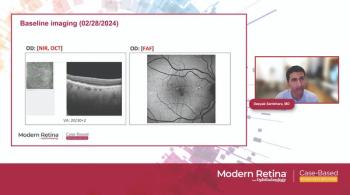
ARVO 2025: Carl Danzig, MD, recaps the first stage of a phase 3 study of drop-based DME therapy
According to Dr. Danzig, the DIAMOND trial demonstrates efficacy of OCS-01, a topical drop, in patients with diabetic macular edema.
Carl Danzig, MD, director of vitreo-retinal services at the Rand Eye Institute in Deerfield Beach, Florida, shared an update on his work in diabetic macular edema (DME) during the Association for Research in Vision and Ophthalmology (ARVO) meeting.
In Salt Lake City, Utah, Dr. Danzig explained a drop-based DME treatment called OCS-01 (Oculis Holding), the subject of the ongoing phase 3 DIAMOND trial.
"We all know that diabetic macular edema is a huge unmet need here in the United States and around the world, and it is one of the leading causes of new cases of blindness in the US," Dr. Danzig said. "Furthermore, there's a high treatment burden. The way we treat DME currently is with injections for the vast majority of cases, occasionally laser, but patients don't want to keep up their appointments. There's non-compliance. So, we have to find a way to better address this need."
In the DIAMOND trial, Dr. Danzig said, a new nanotechnology permitted the highly concentrated dexamethasone eye drop to penetrate through the cornea into the posterior segment. "This is the first time that we have an eye drop that comes from the surface of the eye and penetrates into the retina with efficacy," he explained. "They do this through having a longer duration on the corneal surface and the drug's able to enter with the vehicle that goes through the corneal stroma."
"Think of it like passengers on a train," he continued. "We know that getting through the cornea is difficult. So these passengers on the train, the passengers are the drug." The train cars represent the vehicle, and the train passes through a mountain tunnel—the cornea.
"When it exits on the other side, the passengers get out," Dr. Danzig concluded, "That's the drug, getting out into the anterior segment and then going through to the posterior chamber."
He went on to explain findings from the first phase of the two-stage DIAMOND trial. The first stage was a 12-week trial with a primary endpoint at 6 weeks for a best corrected visual acuity (BCVA) gain. Patients were either treatment-naive or treatment-experienced, with an entrance vision of 24 to 65 ETDRS letters. Patients received either OCS-01 eye drops six times a day for 6 weeks, followed by a maintenance phase of three times per day. Other patients, randomized 1:1 to the vehicle, received just the vehicle at the same frequency—an "empty train car," in Dr. Danzig's analogy.
"What we saw in the clinical trial was an increase in BCVA as early as week 2 in the OCS-01 treatment arm that was increased, that increased further at week 6, and then was maintained until week 12 [with a] 7.6 letter gain," he explained. "So you had six times a day of an eye drop for 6 weeks, followed by three times a day. That gain that was seen at 6 weeks. When you decrease the eye drop to three times a day, that gain was maintained." Investigators reported rapid decrease in central subfield thickness (CST) as early as week 2, and those findings were maintained throughout the end of the 12-week study.
"When you look at lens status—because this was an important thing to look at, phakic and pseudophakic patients—Whether you were phakic or pseudophakic, you had BCVA gains and CST reductions," he said. "There was no increase of cataract formation at week 12, when we look at safety signals, there were no new or unexpected safety signals seen." Based on all of these positive findings, Dr. Danzig said, investigators have moved on to a stage 2 of the phase 3 study. This new stage will examine the DME treatment over 52 weeks, and that stage is now fully enrolled as of April.
Newsletter
Keep your retina practice on the forefront—subscribe for expert analysis and emerging trends in retinal disease management.










































